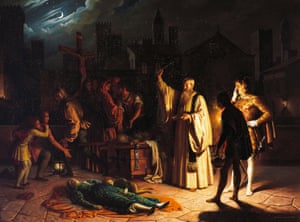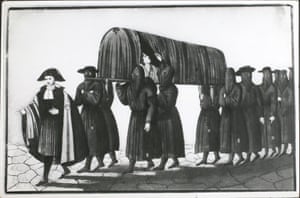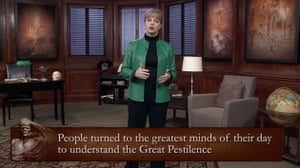Interview
What can we learn about 2020 from the Black Death? Dorsey Armstrong has all the answers
The US professor became an unlikely TV star this year, with a series about the plague. She explains what the 1348 pandemic can tell us today about conspiracy theories, recklessness, deurbanisation and social unrest
Sam Wollaston
@samwollaston
Sun 1 Nov 2020

Sam Wollaston
@samwollaston
Sun 1 Nov 2020

Dorsey Armstrong: ‘It’s not, once we make it through, all sunshine and rainbows, but there is hope for improvement in society.’
Photograph: Jeff Mauritzen/Jeff Mauritzen - inPhotograph/Courtesy of The Teaching Company
A pandemic rages across the globe, leaving a trail of death, confusion and economic ruin, and changing everything. This is a new disease, about which little is understood. People and communities don’t know what to do, and they react in different ways – sensibly, understandably, honourably, idiotically, criminally. Cities go into lockdown, quarantine rules are introduced, new hospitals are built to try to cope with the numbers of sick. There are heroes and acts of kindness and selflessness. There are also deniers, conspiracy theorists, finger pointers. And there are people – including those in positions of leadership and power – who don’t just fail to step up to the plate, but abandon the field of play.
The year is 1348, of course. Not 2020, but you knew that. Different deals: Covid is a virus; the Black Death – the Great Mortality, pestilence, plague – a flea-driven bacterial infection. Now (it still exists) plague is mostly treatable with antibiotics; then, of course, it lived up to its names. “The thing I like to stress to people feeling anxious about Covid is that the mortality rate for the Black Death in the 14th century was about 80%,” says Dorsey Armstrong. With Covid it is far, far lower, “although I understand absolutely it’s not encouraging to people with family members who have gotten ill and who have died”.
Armstrong, 49, is a professor of English and medieval literature at Purdue University in Indiana. She did a series of TV lectures – The Black Death: The World’s Most Devastating Plague – that became an unlikely hit. Made in 2016, way before Covid, it went out on Amazon Prime this year, just as the new pandemic struck and locked-down 21st-century humans looked to the distant past to try to understand what was happening and what may happen next
A pandemic rages across the globe, leaving a trail of death, confusion and economic ruin, and changing everything. This is a new disease, about which little is understood. People and communities don’t know what to do, and they react in different ways – sensibly, understandably, honourably, idiotically, criminally. Cities go into lockdown, quarantine rules are introduced, new hospitals are built to try to cope with the numbers of sick. There are heroes and acts of kindness and selflessness. There are also deniers, conspiracy theorists, finger pointers. And there are people – including those in positions of leadership and power – who don’t just fail to step up to the plate, but abandon the field of play.
The year is 1348, of course. Not 2020, but you knew that. Different deals: Covid is a virus; the Black Death – the Great Mortality, pestilence, plague – a flea-driven bacterial infection. Now (it still exists) plague is mostly treatable with antibiotics; then, of course, it lived up to its names. “The thing I like to stress to people feeling anxious about Covid is that the mortality rate for the Black Death in the 14th century was about 80%,” says Dorsey Armstrong. With Covid it is far, far lower, “although I understand absolutely it’s not encouraging to people with family members who have gotten ill and who have died”.
Armstrong, 49, is a professor of English and medieval literature at Purdue University in Indiana. She did a series of TV lectures – The Black Death: The World’s Most Devastating Plague – that became an unlikely hit. Made in 2016, way before Covid, it went out on Amazon Prime this year, just as the new pandemic struck and locked-down 21st-century humans looked to the distant past to try to understand what was happening and what may happen next
.
Scene of the plague in Florence in 1348, described by Boccaccio, by Baldassarre Calamai. Photograph: Dea Picture Library/De Agostini/Getty Images
We meet the modern way, on Zoom. She is sitting at her desk at home in West Lafayette, Indiana, in front of busy bookshelves. No plague kitsch on display, sadly. In the series she charts the spread of the Black Death across Eurasia from a panelled room decorated with skulls and rats. Standing on an oriental rug and wearing a series of brightly coloured jackets (chosen by her mum), she alternates her angle of delivery as if addressing students on different flanks of a lecture hall. The lessons are scholarly but lively, compelling and human; as likely to reference The Walking Dead as Giovanni Boccaccio’s The Decameron. And she serves them up with relish and a wry wit. So the mass graves of medieval Florence were dug deep, then filled with a layer of bodies, followed by a thin layer of earth, then more bodies, “like how one layers lasagne with cheese”.
It has been an intense few months for Armstrong. Four family members – her parents, her brother and her sister – got Covid-19. All have recovered, though her mother was hospitalised for several weeks and still suffers from exhaustion. Armstrong’s 14-year-old twin daughters have been at home all day, off school. One, who has autism and for whom school was stressful, “likes to tell us that she is having a great coronavirus … For the other, the lack of social contact is really difficult.” At the same time there has been this explosion of interest in her Black Death course, though she stresses she would “prefer that the course languished in oblivion rather than there be Covid-19 sparking an interest in it”.
Different diseases, different times, but a lot of human nature spans the centuries and Armstrong immediately saw parallels. “The thing that is most horrifying about studying the Black Death is that, in the terror, people were looking for anyone to blame,” she says. “These conspiracy theories start to circulate about Jewish populations, that this was a Jewish conspiracy and that Jews were poisoning wells and planned to wipe out medieval Christian society, which of course was absolutely not true. When Covid first erupted we saw, to my distress, scapegoating of people of Asian ancestry because it looked as if the virus had originated in China.” It didn’t help that the US president called it the “China virus” and “kung flu”. She’s not a fan.
When it was clear the Black Death was wiping out whole communities, some turned to God, prayer, even self-flagellation. Others thought, if we are going to go, let’s have a good time. Armstrong hasn’t noticed any whippings today, but the partying is going on. “We see that quite a bit with college campuses where students – 18 to 22 years old, prefrontal cortex not fully developed – have decided they are going to have a good time.”
Advertisement
A loss of confidence in leaders – political, religious – is another parallel. Also deurbanisation. Armstrong witnessed well-to-do New Yorkers heading to their second homes out of town when the city was hit hard in the summer. In Florence – which kind of was the New York of the 14th century – “rich Florentines fled to the countryside to try to avoid the Black Death while the city was suffering”. Then, once everyone had left, the city fathers started dishing out fines, telling people they had to come back to do their jobs. Not unlike essential workers being called back to work today.

Scene of the plague in Florence in 1348, described by Boccaccio, by Baldassarre Calamai. Photograph: Dea Picture Library/De Agostini/Getty Images
We meet the modern way, on Zoom. She is sitting at her desk at home in West Lafayette, Indiana, in front of busy bookshelves. No plague kitsch on display, sadly. In the series she charts the spread of the Black Death across Eurasia from a panelled room decorated with skulls and rats. Standing on an oriental rug and wearing a series of brightly coloured jackets (chosen by her mum), she alternates her angle of delivery as if addressing students on different flanks of a lecture hall. The lessons are scholarly but lively, compelling and human; as likely to reference The Walking Dead as Giovanni Boccaccio’s The Decameron. And she serves them up with relish and a wry wit. So the mass graves of medieval Florence were dug deep, then filled with a layer of bodies, followed by a thin layer of earth, then more bodies, “like how one layers lasagne with cheese”.
It has been an intense few months for Armstrong. Four family members – her parents, her brother and her sister – got Covid-19. All have recovered, though her mother was hospitalised for several weeks and still suffers from exhaustion. Armstrong’s 14-year-old twin daughters have been at home all day, off school. One, who has autism and for whom school was stressful, “likes to tell us that she is having a great coronavirus … For the other, the lack of social contact is really difficult.” At the same time there has been this explosion of interest in her Black Death course, though she stresses she would “prefer that the course languished in oblivion rather than there be Covid-19 sparking an interest in it”.
Different diseases, different times, but a lot of human nature spans the centuries and Armstrong immediately saw parallels. “The thing that is most horrifying about studying the Black Death is that, in the terror, people were looking for anyone to blame,” she says. “These conspiracy theories start to circulate about Jewish populations, that this was a Jewish conspiracy and that Jews were poisoning wells and planned to wipe out medieval Christian society, which of course was absolutely not true. When Covid first erupted we saw, to my distress, scapegoating of people of Asian ancestry because it looked as if the virus had originated in China.” It didn’t help that the US president called it the “China virus” and “kung flu”. She’s not a fan.
When it was clear the Black Death was wiping out whole communities, some turned to God, prayer, even self-flagellation. Others thought, if we are going to go, let’s have a good time. Armstrong hasn’t noticed any whippings today, but the partying is going on. “We see that quite a bit with college campuses where students – 18 to 22 years old, prefrontal cortex not fully developed – have decided they are going to have a good time.”
Advertisement
A loss of confidence in leaders – political, religious – is another parallel. Also deurbanisation. Armstrong witnessed well-to-do New Yorkers heading to their second homes out of town when the city was hit hard in the summer. In Florence – which kind of was the New York of the 14th century – “rich Florentines fled to the countryside to try to avoid the Black Death while the city was suffering”. Then, once everyone had left, the city fathers started dishing out fines, telling people they had to come back to do their jobs. Not unlike essential workers being called back to work today.

Ambulance men of plague-stricken Florence. Photograph: Hulton Archive/Getty Images
I wonder what connection she sees between Covid and the recent protest and unrest in her country, with people calling for a radical change to deeply entrenched inequalities? “It’s not that the pandemic contributes to social unrest, it is that the pandemic allows other systemic problems in society to become more visible. They cannot be controlled or contained or dismissed or covered up because the systems that were in place to maintain a status quo are too busy coping with this other emergency.”
She brings up the serfs in medieval England who were suddenly enabled to tell the lord of the manor they didn’t need to stay with him, instead they could head off down the road where people were desperately needed to work the land, and actually charge wages. “In some places, people who had been at the bottom of the social order were able to carve out a better situation for themselves – if they survived the plague.”
This sounds like good news. And though the same feudal agrarian system no longer exists, even in the US midwest where Armstrong lives, perhaps opportunity for social mobility may emerge from this? “This situation has made plain that the system, especially in the US, is fatally flawed and that there are no safety nets. For the first time I hope that we will begin a conversation about universal basic income. And it’s made clear that if you connect health insurance to employment you are going to have a disaster if people lose their jobs because businesses have shut down. I hope we are going to have another conversation about universal health care in this country.”
Advertisement
Scholars have often said that medieval European society would have continued being medieval for longer had it not been for the Black Death. Also that it sowed the seeds that led to the Reformation and the Renaissance. And while Armstrong doesn’t dispute these positive changes, she points out that it took time for them to register. “It’s not, once we make it through, all sunshine and rainbows, but there is hope for improvement in society.”

Armstrong presenting her show The Black Death: The World’s Most Devastating Plague. Photograph: Courtesy of The Teaching Company
More than a post-Covid new Renaissance, she would like to see a fundamental step backwards to shore up the foundations of society. “It would be great if we get some great literature out of this,” she says. But what she really wants to see is “communal and systemic structures in place that support people that we don’t currently have”. She looks back to Florence – I think Armstrong likes Florence – which set up the first board of health after the first wave of plague.
It’s going to be easier for the historians of the future; there is so much more documentation. “In the case of the Black Death, sometimes you don’t have information,” she says. “What we have that shows the devastation is a lack of information – bureaucratic documents that suddenly cease being continued, or a sudden silence some place because there is no one left to document what happened. Or an increase in people writing wills.”
She is in no doubt that our times will be studied, in detail; not just the 21st century, they will be zooming in much closer. “Someone will say: ‘So, what’s your field of study?’ and they’ll say: ‘Well, I do the mid-portion of 2020, I focus on March through July.’ Another will say: ‘I focus on the second half of the year.’ Because this year has been so unusual in the way it has affected all levels of society and everyone around the world.”
If more people knew about the Black Death, she thinks, things could have been different. “If people had understood the devastation plague had wrought on the medieval world, going into the current pandemic, I think more people would have taken steps to curb the spread of Covid a little earlier.”
She’s not suggesting that Donald Trump wasn’t up on his medieval history, is she? “Or with what is happening right now. Or reality.” And she rattles off the list of failures – delayed lockdown, not enough adequate PPE or accurate test and tracing, no coordinated national plan – that could so easily also be applied to this country. Oh, go on, give him a score, it’s part of your job. Student Trump, out of 10? “Minus 20.”
No comments:
Post a Comment